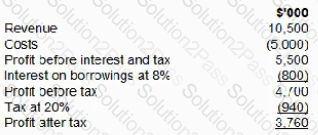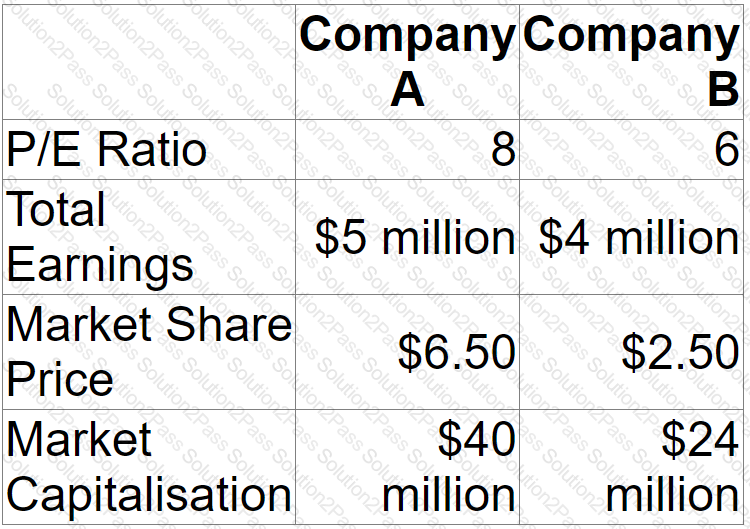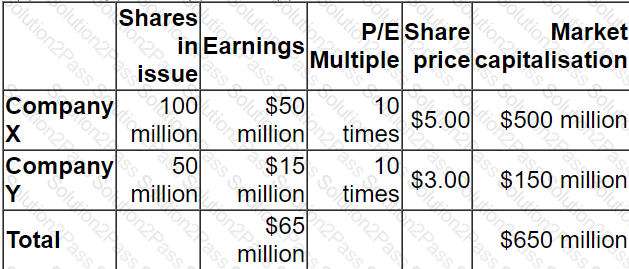F3 CIMA Financial Strategy Free Practice Exam Questions (2025 Updated)
Prepare effectively for your CIMA F3 Financial Strategy certification with our extensive collection of free, high-quality practice questions. Each question is designed to mirror the actual exam format and objectives, complete with comprehensive answers and detailed explanations. Our materials are regularly updated for 2025, ensuring you have the most current resources to build confidence and succeed on your first attempt.
A consultancy company is dependent for profits and growth on the high value individuals it employs.
The company has relatively few tangible assets.
Select the most appropriate reason for the net asset valuation method being considered unsuitable for such a company.
A company is considering taking out $10.000,000 of floating rate bank borrowings to finance a new project. The current rate available to the company on floating rate barrowings is 8%. The borrowings contain a covenant based on an interested cover of5times.
The project is expected to generate the following results:

At what interest rate on the floating rate borrowings is the bank covenant first breached?
A company has 8% convertible bonds in issue. The bonds are convertible in 3 years time at a ratio of 20 ordinary shares per $100 nominal value bond.
Each share:
• has a current market value of $5.60
• is expected to grow at 5% each year
What is the expected conversion value of each $100 nominal value bond in 3 years' time?
Company A is planning to acquire Company B.
Company A's managers think they can improve the performance of Company B to the extent that its own P/E ratio should be applied to Company B's earnings.
Relevant Data:

What is the expected synergy if the acquisition goes ahead?
Give your answer to the nearest $ million.
$ ? million
Select whether the following statements are true or false with regard to Modigliani and Miller's dividend policy theory.

A company has a covenant on its 5% long term corporate bond.
• Covenant - The earnings must not fall below $7 million
The bond has a nominal value of $60 million.
It is currently trading at 80% of its nominal value.
The projected earnings before interest and taxation for next year are $11.5 million.
The company retains 80% of its earnings. It pays tax at 20%.
Advise the Board of Directors which of the following covenant conditions will apply next year?
On 1 January:
• Company X has a value of $50 million
• Company Y has a value of $20 million
• Both companies are wholly equity financed
Company X plans to take over Company Y by means of a share exchange. Following the acquisition the post-tax cashflow of Company X for the foreseeable future is estimated to be $8 million each year. The post-acquisition cost of equity is expected to be 10%.
What is the best estimate of the value of the synergy that would arise from the acquisition?
A venture capitalist is considering investing in a management buy-out that would be financed as follows:
• Equity from managers
• Equity from a venture capitalist
• Mezzanine debt finance from a venture capitalist
• Senior debt from a bank
The venture capitalist is planning to work with the management to grow the business in anticipation of an initial public offering within five years.
However, the cash forecast shows a potential shortage of funds in the first year and the venture capitalist is evaluating the potential impact of cash being generated in the first year being significantly lower than forecast.
The most important risk that a shortage of cash would create for the management buyout is that the new company has insufficient funds to:
A company has a cash surplus which it wishes to distribute to shareholders by a share repurchase rather than paying a special dividend.
Which THREE of the following statements are correct?
A manufacturing company is based in Country L whose currency is the L$.
One of the company's products is exported to Country M, a rapidly growing economy, whose currency is the M$.
In the most recent financial year:
• 100,000 units of the product were sold to customers in country M
• The unit selling price was M$12
The spot rate today is L$1 = M$5
The company has an objective of growth in total sales value in L$ of 10% a year.
If the L$ strengthens by 5% next year against the M$, what volume of sales of this product is needed next year to achieve the objective?
Which THREE of the following non-financial objectives would be most appropriate for a listed company in the food retailing industry?
Company Z wishes to borrow $50 million for 10 years at a fixed rate of interest.
Two alternative approaches are being considered:
A. Issue a 10 year bond at a fixed rate of 6%, or
B. Borrow from the bank at Libor +2.5% for a 10 year period and simultaneously enter into a 10 year interest rate swap.
Current 10 year swap rates against Libor are 4.0% - 4.2%.
What is the difference in the net interest cost between the two alternative approaches?
A company has an opportunity to invest in a positive net present value project, but the project would require debt finance that would push the company's gearing ever a limit imposed by a debt covenant on an existing loan.
Which THREE of the following actions could be taken by the company?
A company is planning a share repurchase programme with the following details:
• Repurchased shares will be immediately cancelled.
• The shares will be purchased at a premium to the market share price.
The current market share price is greater than the nominal value of the shares.
Which of the following statements about the impact of the share repurchase programme on the company's financial statements is correct?
Which TWO of the following situations offer arbitrage opportunities?
A)

B)

C)

D)

On 31 October 20X3:
• A company expected to agree a foreign currency transaction in January 20X4 for settlement on 31 March 20X4.
• The company hedged the currency risk using a forward contract at nil cost for settlement on 31 March 20X4.
• The transaction was correctly treated as a cash flow hedge in accordance with IAS 39 Financial Instruments: Recognition and Measurement.
On 31 December 20X3, the financial year end, the fair value of the forward contract was $10,000 (asset).
How should the increase in the fair value of the forward contract be treated within the financial statements for the year ended 31 December 20X3?
If a company's bonds are currently yielding 8% in the marketplace, why would the entity's cost of debt be lower than this?
A venture capitalist invests in a company by means of buying:
• 9 million shares for $2 a share and
• 8% bonds with a nominal value of $2 million, repayable at par in 3 years' time.
The venture capitalist expects a return on the equity portion of the investment of at least 20% a year on a compound basis over the first 3 years of the investment.
The company has 10 million shares in issue.
What is the minimum total equity value for the company in 3 years' time required to satisify the venture capitalist's expected return?
Give your answer to the nearest $ million.
$ million.
Company X plans to acquire Company Y.
Pre-acquisition information:

Post-acquisition information:
Total combined earnings are expected to increase by 10%
Total combined P/E multiple will remain at 10 times
Which of the following share-for-share exchanges will result in an increase of 10% in Company X's share price post-acquisition?
A company is considering the issue of a convertible bond compared to a straight bond issue (non-convertible bond).
Director A is concerned that issuing a convertible bond will upset the shareholders for the following reasons:
• it will dilute their control
• the interest payments will be higher therefore reducing liquidity
• it will increase the gearing ratio therefore increasing financial risk
Director B disagrees, and is preparing a board paper to promote the issue of the convertible bond rather than a non-convertible.
Advise the Director B which THREE of the following statements should be included in his board paper to promote the issue of the convertible bond?


